by Darren Griffin
 Introduction Introduction
We reviewed the nuvi 760 back in September of 2008 here. I've now had it's bigger brother, the nuvi 765 for a few months. From the outside the 765 is identical to the 760 but it has new software which adds 3D buildings, Lane Assist and other improvements to the specification.
Like the 760, the 765 uses the 4.3" screen and has TMC Traffic and an FM Transmitter amongst its features. Where it differs from the 710 is in its inclusion of a full Western Europe map and Text to Speech (TTS). Instead of 'Turn right in 500 meters' you get 'Turn right onto High Street' which is a useful addition.
As we took a close look at the Nuvi 760 I've opted to write my findings as a supplement to that review concentrating on the ares where the 765 differs.
Garmin's 765 sits towards the top end of the extensive Nuvi model line up. Like the 765 it uses the 4.3" screen and has TMC Traffic and FM Transmitter.
In the Box
Open the box and you'll find the following:
- Garmin Nuvi 765
- Windscreen Mount
- GTM21 FM Traffic Receiver / Power Supply
- Dashboard Mounting Plate
- USB Lead
- Leather Case
- Quick Start Guide
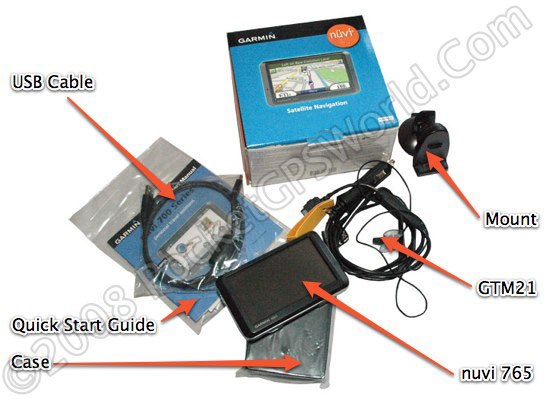
The only obvious omission is a mains power supply but this is far from unusual, few devices include them these days. As it can be charged from a USB port on your computer it's not a huge issue.
So without further delay, let's get it installed in the car and take it for a test drive.
Installation
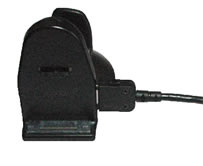 Ok my first gripe, the mount. The ball socket on the rear of the mount wasn't tight enough on my review sample. When installed in the car every bump in the road would cause it to move. The only way around it was to position it such that a corner of the device rested on the instrument binnacle. Ok my first gripe, the mount. The ball socket on the rear of the mount wasn't tight enough on my review sample. When installed in the car every bump in the road would cause it to move. The only way around it was to position it such that a corner of the device rested on the instrument binnacle.
This may be a symptom of a well used and abused press hack device but it shouldn't happen. I'm also not a fan of the GTM21 power/traffic antenna solution. This is very poorly designed with the multi-function power/data connector exiting the mount at right angles and thus placing the weight of the cable directly on the connector. Time will tell if this proves to be a weak point.
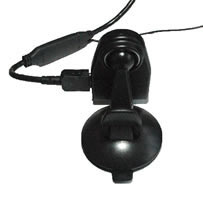 The power/data cable splits at a junction about 2 inches out from the mount so that the antenna for the FM RDS-TMC can be affixed to the windscreen. This again has been poorly considered. The junction is a small plastic package about the size of a USB memory stick further adding to the stress on the connector. The power/data cable splits at a junction about 2 inches out from the mount so that the antenna for the FM RDS-TMC can be affixed to the windscreen. This again has been poorly considered. The junction is a small plastic package about the size of a USB memory stick further adding to the stress on the connector.
Because of the design it's very difficult to install the cabling neatly. I detest unsightly cables and with the mount installed adjacent to the A-Post I was left with the power lead draped over the steering column and a string antenna for the Traffic feature stuck to the glass up the A-Post and across the top of the windscreen.
Affixing the 765 to the mount was relatively straightforward although I did struggle to line up the unit with the two locating pins on the mount more frequently than I would have liked. Removal is a reversal of the installation process initiated by pressing the bottom mounted release button, the sighting of which prevent the unit from being installed with the mount resting on the dash!
Given how important a good mount is it irks me that such shoddy solutions are allowed out of the lab!
In-Use
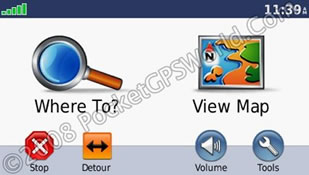 Those who use Garmin devices will know the menu layout. For the key functions it's easy to use with a clean intuitive interface that is easy to navigate and simple to interpret. Those who use Garmin devices will know the menu layout. For the key functions it's easy to use with a clean intuitive interface that is easy to navigate and simple to interpret.
Garmin's solution is not for the tinkerer though. Customisation and other options are limited and buried in obscure sub-menus but for the vast majority it offers a simple, easy to use navigation tool.
When you switch on (after the compulsory message warning you not to use the device whilst driving) you are taken to the main screen as seen on the right. A fine example of a clean and simple interface. Tapping 'Where to?' takes you to the main navigation menu shown in expanded mode here:
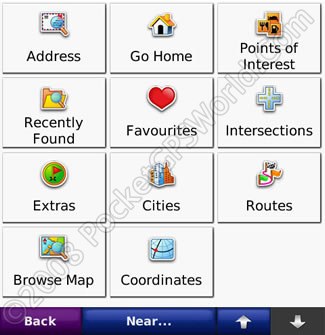
Clear Menu Layout
Here you can see all your navigation options, address, home, POI etc. Selecting address takes you to the keyboard entry screen where you can enter the destination city or Postal Code.
Another key area where the 765 differs from our 760 review is in the ability to customise the information fields available on the map display. By tapping the information fields you can change the information to one of 6 data options. Speed is always dislayed. This was a complaint of the 760 and it is nice to see it has been answered here.

Lane Assist and Reality View make a first appearance on the 765 and they have been superbly implemented. You can dee below how Lane Assist appears. As you approach an intersection or other road feature a pictorial guide of the lanes appears at top left indicating the lanes that you need to be in. Nice, clear and simple.
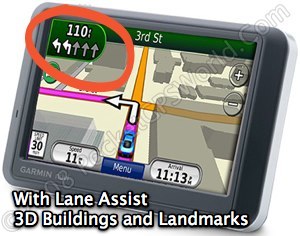
Similarly, Garmin's Reality View is one of the best I've seen with clear static images of the junction layout and road signage.
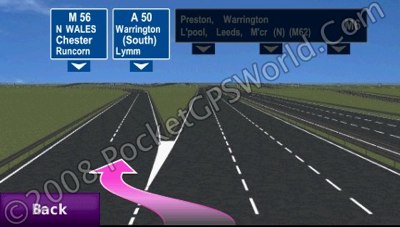
Reality View
3D Buildings look good but I'm not yet convinced as to their usefullness. However, 3D buildings do appear to severly impact screen redraw speed when they are present on the map and whilst nice the first time you see them are of little benefit, particularly if they are going to hamper performance as they appear to do.
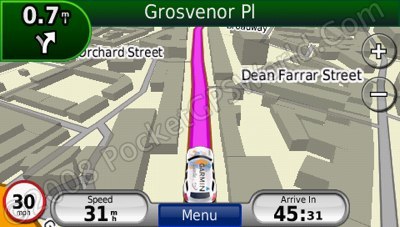
3D Buildings
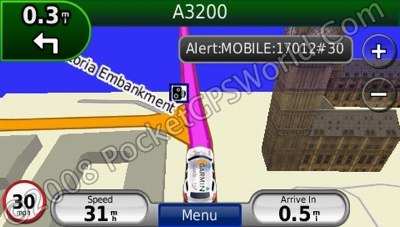
3D Landmarks
The little car cursor can be changed, Garmin have a growing selection you can choose from but the image is animated and so they have prevented you from making your own. Quite why it's animated I haven't quite figured out as you rarely see the animation. At junctions you might see a jerky side view of the car as you turn but it adds nothing and is a waste of resource in my opinion.
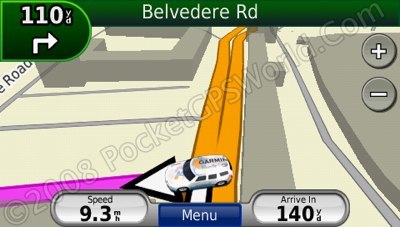
Specification
| Dimensions |
12.2 x 7.6 x 2.0 cm |
| Display |
9.7 x 5.7 cm (4.3") |
| Display resolution |
480 x 272 pixels |
| Weight |
190g |
| Battery |
Rechargeable Li-Ion |
| Battery life |
up to 5 hrs |
| GPS Chipset |
SiRFStarIII |
Conclusion
I wanted so much to like this device. I started off my GPS career with a military Garmin unit and have been a Garmin user for many years. The Nuvi 760 is a good unit let down by some key issues that I couldn't live with. Although I accept that for the average user it may be a perfectly good solution the poor mount is inexcusable and lack of configuration options is disappointing in a high-end model such as this.
The interface is simple to use for the main functions but some of the lesser used features are buried in sub menus and thus hard to locate. Whilst it is important to display only key information I think the main map screen has been overly simplified in my opinion.
If you're after a solution that makes the main navigation function simple and require little in the way of fine tuning or user configuration then this would tick all the boxes but it's a very expensive solution to that requirement and is matched or bettered by a great many other solutions for less money.
|